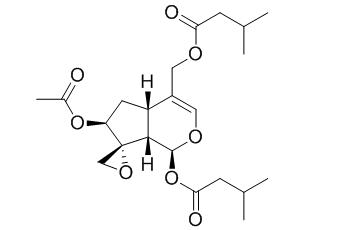Didrovaltrate
Didrovaltrate shows cytotoxic against human cancer cell lines. Didrovaltrate blocks I(Ca-L) in a concentration-dependent manner and probably inhibits I(Ca-L) in its inactive state, which may contribute to its cardiovascular effect.
Inquire / Order:
manager@chemfaces.com
Technical Inquiries:
service@chemfaces.com
Tel:
+86-27-84237783
Fax:
+86-27-84254680
Address:
1 Building, No. 83, CheCheng Rd., Wuhan Economic and Technological Development Zone, Wuhan, Hubei 430056, PRC
Providing storage is as stated on the product vial and the vial is kept tightly sealed, the product can be stored for up to
24 months(2-8C).
Wherever possible, you should prepare and use solutions on the same day. However, if you need to make up stock solutions in advance, we recommend that you store the solution as aliquots in tightly sealed vials at -20C. Generally, these will be useable for up to two weeks. Before use, and prior to opening the vial we recommend that you allow your product to equilibrate to room temperature for at least 1 hour.
Need more advice on solubility, usage and handling? Please email to: service@chemfaces.com
The packaging of the product may have turned upside down during transportation, resulting in the natural compounds adhering to the neck or cap of the vial. take the vial out of its packaging and gently shake to let the compounds fall to the bottom of the vial. for liquid products, centrifuge at 200-500 RPM to gather the liquid at the bottom of the vial. try to avoid loss or contamination during handling.
Nutrients.2018, 10(7)
BMC Complement Altern Med.2018, 18(1):303
Adaptive Medicine 2020, 12(1): 4-10
Molecules.2021, 26(9):2791.
Int J Mol Sci.2023, 24(14):11496.
Pharmaceuticals (Basel).2024, ;17(8):1018.
J. of The Korean Society of Food Culture2017, 144-149
Industrial Crops and Products2018, 353-362
Phytomedicine.2019, 62:152962
Natural Product Sciences2023, 29(4):276-280.
Related and Featured Products
J Tradit Chin Med. 2012 Sep;32(3):442-5.
Effect of didrovaltrate on I-calcium current in rabbit ventricular myocytes.[Pubmed:
23297570]
To investigate the effect of Didrovaltrate on L-type calcium current (I(Ca-L)) in rabbit ventricular myocytes.
METHODS AND RESULTS:
We used the whole cell patch clamp recording technique.
Didrovaltrate at concentrations of 30 microg/ L and 100 microg/L significantly decreased peak I(Ca-L) (I(Ca-Lmax)) from (6.01 +/- 0.48) pA/pF to (3.45 +/- 0.27) pA/pF and (2.16 +/- 0.19) pA/pF (42.6% and 64.1%, n=8, P< 0.01), respectively. Didrovaltrate shifted upwards the current-voltage curves of I(Ca-L) without changing their active, peak and reverse potentials. Didrovaltrate affected the steady-state inactivation of I(Ca-L). The half activation potential (V1/2) was significantly shifted from (-26 +/- 2) to (-36 +/- 3) mV (n=6, P<0.05), with a significant change in the slope factor (k) (from 8.8 +/- 0.8 to 11.1 +/- 0.9, n=6, P<0.05). Didrovaltrate did not affect the activation curve.
CONCLUSIONS:
Didrovaltrate blocks I(Ca-L) in a concentration-dependent manner and probably inhibits I(Ca-L) in its inactive state, which may contribute to its cardiovascular effect.
Plant Cell Rep. 2004 Oct;23(4):251-5.
Control of development and valepotriate production by auxins in micropropagated Valeriana glechomifolia.[Pubmed:
15252693]
Valeriana glechomifolia is a plant species endemic to southern Brazil that accumulates valepotriates, which are terpene derivatives, in all of its organs. Valepotriates are the presumed sedative generic components of the pharmaceutically used species of Valeriana.
METHODS AND RESULTS:
The influence of various concentrations of the auxins indole-3-acetic acid, indole-3-butyric acid and alpha-naphthaleneacetic acid on the growth of micropropagated V. glechomifolia was investigated under conditions of transient and continuous exposure. Changes in the development of roots and shoots as well as the production of the valepotriates acevaltrate, valtrate and Didrovaltrate (analyzed by high-performance liquid chromatography) were evaluated.
CONCLUSIONS:
The best performance in valepotriate production, growth and survival under ex vitro conditions following plant acclimatization was achieved in the continuous presence of 5.71 microM IAA. When cultured in medium containing IAA plants produced stable levels of valepotriates throughout the entire cultivation period.
Phytomedicine. 1998 May;5(3):219-25.
Cytotoxic potential of valerian constituents and valerian tinctures.[Pubmed:
23195845 ]
Underground parts of three Valeriana species, namely V. officinalis L. s.l., V. wallichii DC. (V. jatamansi Jones), and V. edulis Nutt. ex Torr & Gray ssp. procera (H.B.K.) F. G. Meyer (V. mexicana DC.), are used in phytotherapy because of their mild sedative properties.
METHODS AND RESULTS:
Characteristic constituents of these species, which are regarded also as the active principles, were tested for cytotoxicity against GLC(4), a human small-cell lung cancer cell line, and against COLO 320, a human colorectal cancer cell line, using the microculture tetrazolium (MTT) assay. Valepotriates of the diene type (valtrate, isovaltrate and acevaltrate) displayed the highest cytotoxicity, with IC50 values of 1-6 μM, following continuous incubation. The monoene type valepotriates (Didrovaltrate and isovaleroxyhydroxyDidrovaltrate) were 2- to 3-fold less toxic. Baldrinal and homobaldrinal, decomposition products of valepotriates, were 10- to 30-fold less toxic than their parent compounds. Isovaltral had a higher cytotoxicity than its parent compound isovaltrate. Valerenic acids (valerenic acid, acetoxyvalerenic acid, hydroxyvalerenic acid and methyl valerenate), which are characteristic for V. officinalis, had a low toxicity with IC(50) values between 100 and 200 μM. Freshly prepared and stored tinctures, prepared from roots and rhizomes of the three valerian species, were analysed for valepotriates, baldrinals and valerenic acids, and also tested for cytotoxicity.
CONCLUSIONS:
There was a clear relationship between the valepotriate contents of the freshly prepared tinctures and their toxicity. Upon storage, valepotriates decomposed, which was reflected in a significant reduction of the cytotoxic effect.



